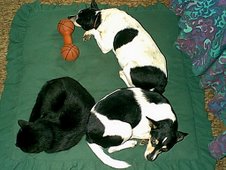As a companion, the Labrador Retriever is good-natured and gentle enough to accept the roughhousing of youngsters without returning it.
The Labrador has been America's most popular dog for many years in succession, and has featured at the top of the list of the ten most popular breeds in America for some time.
We will go over some of the basic characteristics of the Labrador Retriever to help you get a better understanding of the Labrador Retriever as a breed and possibly a new addition to your family. The purpose of this article is to improve the public’s knowledge about dogs, the Labrador Retriever in particular.
Labrador Retrievers have an abundance of self-control and loyalty, but they do not make very good watchdogs. If you really need a good watchdog get your Labrador a German Shepherd friend.
Obedience-trained Labradors as well as other breeds are being used as Therapy Dogs to enrich the lives of residents and even emotionally disturbed children in nursing homes.
Regular nail trimming is important. Nails that are not properly clipped can crack and split, which can lead to infection.
A regular trimming, at least once a week or every two weeks, will save both you and your Labrador Retriever a lot of pain and aggravation.
Purchase a good quality nail clipper. You might also want to purchase a clotting agent, such as Kwik-Stop, or even a styptic pen. Some times nails are clipped too short and bleeding occurs.
A good tip is to use a flashlight and shine through the back of the nail to locate the quirk. (Pink part of the nail), which is the live tissue inside the nail.
The suburbs may be the best of Labrador Retriever worlds, but its environment poses its own special set of problems. " Having a Labrador Retriever under one's "direct control" is, of course, an ambiguous phrase.
Residents do not always obey leash laws. Free-roving dogs often form packs or bite, a growing problem in many suburbs and villages.
In cities stray dogs are picked up promptly and impounded. The best and most humane way is to bring the dog into the house where it belongs, and can be more easily obedience-trained.
Newfoundland
Labradors originated from the coast of Newfoundland in the 17th Century. They were both known as Newfoundland dogs and it was not until 1812 that the larger breed was known as Newfoundlands, and the smaller as the lesser Newfoundland or Labrador. There are two portions to the Province, the Island of Newfoundland is located in the Gulf of St.Lawrence and Labrador is on the Eastern part of the Canadian mainland. Separated by the Strait of Belle Isle.
The Island of Newfoundland is 111,390 square kilometers and Labrador is 294,330 square kilometers making the total area of the Province 405,720 square kilometers.
People
People seem to believe that a hunting dog can be left outside and kenneled and yet not all hunting dogs make good "kennel dogs" and the Labrador Retriever is one of those. This is a breed that is a close relative of the Newfoundland, it is a people oriented dog with a natural desire to be with people. A Labrador retriever can also be trained as service dogs to assist people with special needs such as Autism, Epilepsy or any other seizures condition, visual impairment, physical handicap and so much more.
For physically handicapped people, they can retrieve certain things or do particular tasks for them.
Labs
Retrievers were originally bred as hungting dogs. They were taught to sit by the hunter and wait until game was shot and then retrieve it on command. This meant sometimes swimming through cold water or running through dense brush. Labs were also taught not to damage the game upon returning it to their master.
Working retrievers had no use for aggression since handling birds roughly or growling at other hunters goes against their friendly nature. They will gladly hunt with anyone, or play fetch with anyone who is willing. They tend to see everyone as a friend or potential playmate.
Labradors are sound insensitive so that the loud bang of a hunter's gun won't disturb them. Loud noise, such as that from children, does not tend to bother labs and yelling at them will generally not get a response.
Labs are large dogs, normally around fifty to seventyfive pounds.
Yellow labs can vary from nearly white to fox red, but the other two colors are pretty much all the same.
I am not the author of this article.
Unfortunately the authors name got lost and I apologize.
However, I have included this article to better understand the Labrador.
Thursday, 08 February 2007
Subscribe to:
Post Comments (Atom)


No comments:
Post a Comment